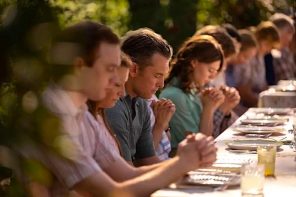Clearly, atheist-provocateur Christopher Hitchens fancies the word “sinister”: he’s used it to describe celebrated playwright Harold Pinter, Prince Charles, Howard Dean, and anti-war activist Cindy Sheehan. And, on Monday in Slate, to characterize Mormonism as well. In fact, to hear Hitchens’s take on Mitt Romney’s religion, Mormonism might be the sinisterest of them all.
Essays like Hitchens’s recycle old images of Mormon mindlessness, manipulation, and sinisterestness. No doubt, America is far from being done with its Mormon moment. Mormons continue to take it pretty much in stride — witness Mitt Romney’s response to the Jeffress “cult” remarks during last night’s debate—“I’ve heard worse. I won’t lose any sleep over it.”
Of course, it surprises none of us that Hitchens would elect to weigh in on the Mormon moment. But what is noteworthy about the essay is how sloppy and hysterical he sounds. Predictably, Hitchens folds in the most sensational details of Mormon life—no one, it seems, can resist a mention of the underwear—and fixates on the least proud moments of Mormon history—including the posthumous baptism of Holocaust victims. But Hitchens also gets some facts about Mormon life and doctrine wrong: there is nothing, for example, in the Book of Mormon that references African-Americans or legitimates the historical ban on black priesthood. People of African descent were ordained to the Mormon priesthood from the 1830s through 1880s, and although ordination was discontinued and institutionalized as a racist ban until 1978, but the Book of Mormon provides no direct rationale for LDS anti-black institutional racism.
And no Mormon who understands vicarious baptism for the dead believes that the simple act of proxy baptism actually converts the souls of the dead into Mormons. The practice of baptism for the dead (which is referenced in 1 Corinthians 15:29) in theory allows living believers to perform the rite of baptism—understood by many Christians to be essential to salvation—by proxy for deceased ancestors. Even the most orthodox LDS theology holds that baptisms are null and void unless welcomed by the souls of the departed. Proxy baptisms are in policy to be limited to ancestors as an expression of a Mormon theological view that the spiritual well-being of souls is connected with the spiritual well-being of their ancestors as well. That’s the policy, but in practice the process has been abused many times, often by well-intentioned but ignorant people who submit names of non-relatives for baptism with no acknowledgment of the fact that others might consider such baptism an affront. (Top-notch religion journalist Peggy Fletcher Stack provides the best account of the problem and LDS Church attempts at its rectification here. But as Maureen Dowd’s column today suggests, there is no doubt that baptism for the dead will continue to be a sticky subject for the Church and a troubling subject for non-LDS people this election year.)
The article has already drawn its share of responses, one of my favorite from Slate columnist David Haglund, who was raised LDS. Haglund offers a humanizing if indirect response to Hitchens by pointing to the “I’m a Mormon” ad campaign—now featuring The Killers’ Brandon Flowers—and member-generated profiles on the mormon.org site as evidence of non-sinister Mormon humanity. Even if the ads overstate the diversity of the faith, as Haglund suggests, how Mormons navigate our faith is certainly more complicated than Hitchens allows, especially when he characterizes us as a uniform mass that can, for example, be “ordered” by our “supreme leaders” to “turn about and shun any members who show any signs of backsliding.” Yes, there are certainly orthodox Mormons (like orthodox members of any faith) who coldly reject family members who leave the tradition, but legions of backsliding Mormons will also attest that Mormon congregations can be counted on to bring just-baked bread and brownies to the doorsteps of folks who have gone missing. Mormons are a mixed lot—and this point is an important one, because the success of essays like Hitchens’s depends upon the glib confidence of the cognoscenti: Mormons—sigh—what dupes! Joseph Smith—what a con! As if none of us had actually read Fawn Brodie’s No Man Knows My History and still found reasons to identify with the faith, even if on our own terms. As if none of us had reviewed the evidence and then, for better or worse, continued to cast our lots with the tradition our ancestors built. As if none of us had consciously chosen to adhere to a religion we knew people would ridicule.
But it’s not that glib dismissiveness I want to address here. It’s the fact that in depicting Mormons as “sinister” Hitchens is not trading in snarky cosmopolitan cool. Rather, he’s dusting off a century-old Anglo-American tradition of anti-Mormon caricature, that vests his below-average essay with a specific value and intensity.
Witness this 1904 cartoon from the magazine Puck, an artifact of the turn of the century’s anti-Mormon hysteria, when national debate erupted over whether Utah Senator Reed Smoot should be allowed to assume a seat in Congress:

(Image source here.)
The cartoon depicts politician Smoot as the puppet of a raggedy but fearsome (even occultish—note the horned ears) Mormon prophet. In political cartoons from the 1880s through 1910s, Mormonism was often depicted in a similarly sinister guise, for example, as a viper or an octopus strangling American democracy. University of Maryland law professor Martha Ertman observes, “Again and again, commentators from high culture (media and legal experts mainly) and popular culture (cartoonists and authors of magazine articles) portray[ed] Mormons as barbaric, lascivious, despotic, disorderly, foreign, black, Asian, and/or childish.”
The question is will people actually know anything more about the seven million Mormons who live, work, and vote in this country when the elections are over? Or will folks like Hitchens be content to remain in a frame of reference minted more than a century ago?




